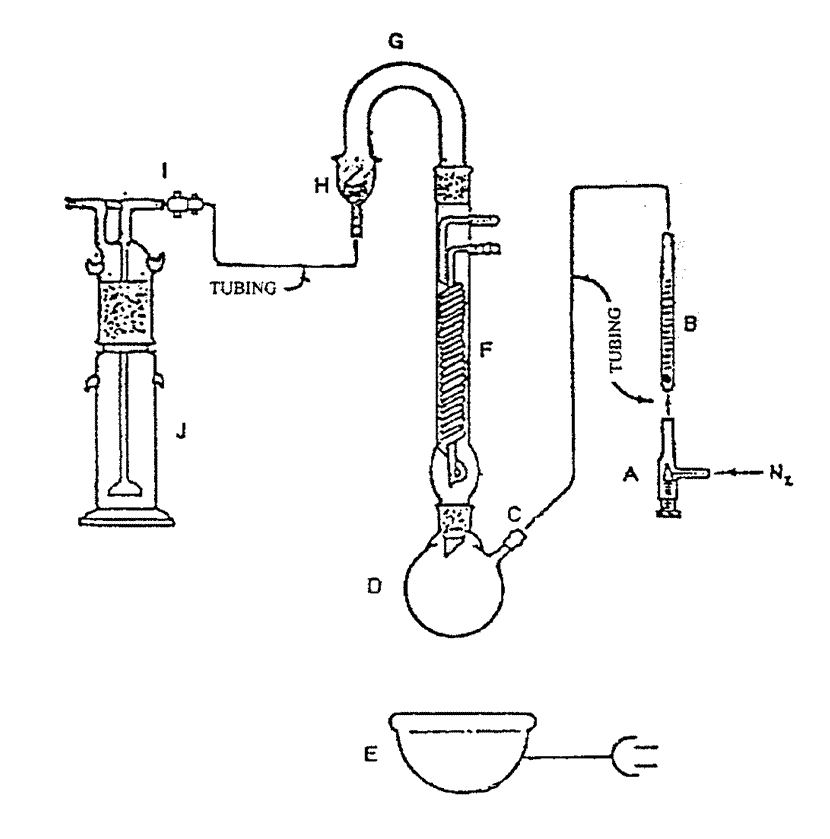á311ñALGINATES ASSAY
APPARATUS
The required apparatus (see Figure 1)contains a capillary metering valve,A,followed by a flowmeter,B,to control and monitor the flow of nitrogen through the system.Halogenated vinyl plastic tubing*and a rubber fitting,C,are used to connect the flowmeter to a sidearm of a reaction flask,D.Flask Dis a 250-mLround-bottom,boiling flask,resting in a suitable heating mantle,E.Flask Dis provided with a 225-mm Hopkins coil reflux condenser,F.The condenser terminates in a U-shaped trap,G,which contains two 25-g bands of 20-mesh zinc,the bands being bounded and separated by three 3-inch plugs of glass wool.The trap terminates in an adapter,H,that by means of a halogenated vinyl plastic tubing and a twistcock connector,I,connects with a 250-mLgas washing bottle,J.The inlet (bubbling)tube extends almost to the bottom of the gas washing bottle,and it terminates in a fritted disk having a coarse porosity.The size of all glass joints is 24/40,except for the 45/50joint of the gas washing bottle.
SYSTEM SUITABILITY
Using D-glucuronolactone as the standard,proceed as directed for Procedure,but do not perform preboiling steps.The system is suitable if the following criteria are met:(1)a blank determination results in a net titration value C,between 0.02and 0.06mEq of 0.1Nhydrochloric acid,calculated as follows:
Ab–Bb,
in which Abis the number of mEq of 0.25Nsodium hydroxide in the 25mLused,and Bbis the number of mEq of 0.1Nhydrochloric acid used in the blank titration;and (2)the percentage of carbon dioxide,CO2,obtained from the standard is between 24.7%and 25.3%.
PROCEDURE
Unless otherwise directed in the individual monograph,transfer a specimen of about 250mg,accurately weighed,into the reaction flask,D,add 50mLof 0.1Nhydrochloric acid,insert several boiling chips,and connect the flask to the reflux condenser,F,using phosphoric acid as a lubricant.[NOTE—Stopcock grease may be used for the other connections.]Connect the nitrogen line to the sidearm of the flask,and adjust the flow of cooling water to about 2Lper minute.
[NOTE—The following preboiling steps,outlined in this paragraph,are optional and need only be performed when the presence of inorganic carbonates is suspected.]Maintain the flow of nitrogen through the apparatus at 90to 100mLper minute.Raise the heating mantle,E,to the flask,heat the specimen to boiling,and boil gently for 2minutes.Turn the heat off,lower the mantle,E,and allow to cool for about 10minutes.
Connect the empty gas washing bottle assembly,J,and sweep the system with nitrogen at a rate of 90to 100mLper minute for 5minutes.Reduce the nitrogen flow to 60to 65mLper minute,add 10drops of butyl alcohol,25.0mLof 0.25Nsodium hydroxide VS,and 50mLof distilled water into the bottle,rinsing down the inside of the gas washing bottle,and replace the cap.Detach the rubber fitting,C,from sidearm,and add 46mLof hydrochloric acid through the sidearm of the boiling flask.Reattach the nitrogen line,raise the heating mantle,and heat the reaction mixture to boiling.After 2hours of boiling,increase the nitrogen flow to 90to 100mLper minute,discontinue the heating,and lower the mantle.Allow to cool for 10minutes.Disconnect,and disassemble the gas washing bottle.Using a directed stream of distilled water,thoroughly rinse all parts of the bubbling tube and cap,collecting the washings in the gas washing bottle.Use nitrogen to gently force all water out of the bubbling tube.To the bottle immediately add 10mLof 10%barium chloride solution and a stirring bar.Insert a tight stopper,and stir gently for 1minute.Allow to stand for at least 5minutes.Add three drops of phenolphthalein TS,and titrate with 0.1Nhydrochloric acid VS.Perform a blank determination (see Residual Titrationsunder Titrimetry á541ñ).Calculate the percentage of carbon dioxide,CO2,by the formula:
2200[(A-B)-C]/(1000W)(1-D),
in which Ais the number of mEq of 0.25Nsodium hydroxide in the 25mLused;Bis the number of mEq of 0.1Nhydrochloric acid used for the titration of the sample or the standard;Cis the net titration value calculated in the blank determination;Wis the weight,in g,of the sample or the standard taken;and Dis the percentage expressed as a decimal (1decimal place),obtained in the test for Loss on dryingfor the sample or for the standard.
*
This type of tubing is commonly referred to as Tygon tubing.This note is added for clarity and it does not constitute USP's endorsement of this product.
